We often think of the Moxon rectangle as strictly an HF antenna. However, its small size and special far field pattern lend themselves to some VHF applications. So let's see how to adapt the design to 2 meters (as a popular band choice) and also see a few of the uses to which we may effectively put the design.
Basic Moxon 2-Meter Properties
The Moxon rectangle is a parasitic 2-element array with the ends of each element folded back towards each other for additional coupling. The result is a beam with a very broad beamwidth and a very high front-to-back ratio, with a gain similar to that of a standard 2-element Yagi. Fig. 1 sketches the general outline of the antenna with the crucial dimensions designated by letters.
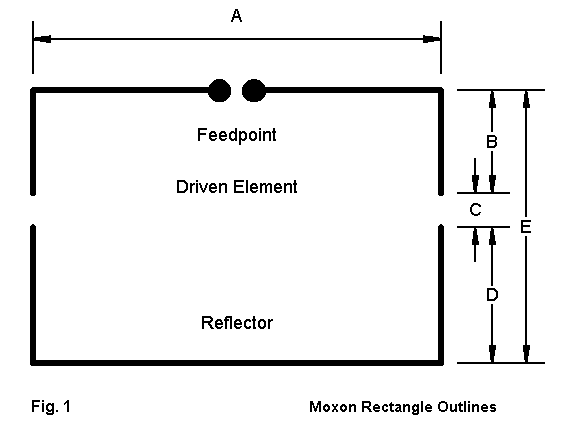
When scaling the Moxon rectangle to VHF, the typical materials we use to make antennas will have a much greater diameter as a percentage of a wavelength than do the materials we use at HF. Hence, to obtain the same performance as at HF, VHF versions of the antenna will have proportionately larger gaps between element ends. The larger gap then forces some changes in other dimensions to achieve the desired gain, front-to-back, and feedpoint impedance characteristics. In Table 1 are modeled dimensions for three rectangles using different diameter materials. All dimensions are in inches.
Dimension Material
1/4" dia. 1/2" dia. 1" dia.
A 29.2" 28.8" 28.2"
B 3.65" 3.42" 3.17"
C (gap) 1.70" 2.04" 2.12"
D 5.45" 5.58" 5.76"
E 10.80" 11.04" 11.05"
From these examples, the average builder can interpolate dimensions for materials with intermediate diameters. Note that as the material diameter increases, everything gets a little shorter except for the gap and the reflector tails. The larger diameter materials provide closer coupling between element ends and thus must be widened to restore performance. The driven element gets shorter overall, with a smaller side-to-side dimension as well as shorter tails to provide the 50-Ohm feedpoint impedance. As the driver grows shorter, the reflector grows shorter by a smaller amount (about 0.4" from the smallest to the largest diameter material in the table). Since we keep the side-to-side dimension the same for both driver and reflector and since that dimension is growing shorter with fatter elements, we must lengthen the tails of the larger diameter models. With a wider gap and longer reflector tails, 50-Ohm rectangles will be wider from front-to-back as we increase the element diameter.
There is no significant difference in the performance of copper or aluminum, since the diameter of all of the elements is great enough to make the material losses very low. Table 2 lists the predicted performance of the 3 antenna versions at 144, 146, and 148 MHz. All numbers are free space modeled values.
Parameter 1/4" dia. 1/2" dia. 1" dia.
144 146 148 144 146 148 144 146 148
Gain dBi 6.4 6.0 5.7 6.2 6.0 5.7 6.2 6.0 5.8
F-B dB 18 33 21 22 35 21 22 33 25
Feed Z:
R 39 50 60 44 53 61 45 54 61
jX -11 0 +8 -8 0 +6 -6 0 +4
50-Ohm SWR 1.4 1.0 1.3 1.2 1.0 1.3 1.2 1.0 1.2
The fatter the elements, the broader the characteristics of the antenna across the band. Clearly, however, all three element diameters will perform quite well across the 2-meter band. Hence, the choice of materials will be whatever you find easiest to work with and most desirable for a given application.
One would not normally select the Moxon rectangle for gain. Simple Yagis with 3 or more elements can provide higher gain without the complexity of bending the elements and maintaining the critical gap between element ends. The Moxon rectangle recommends itself wherever one needs any one or more of the following properties:
Most of the positive properties of the rectangle appear in Table 2. To supplement the numbers there, we can look at some overlaid free space patterns.
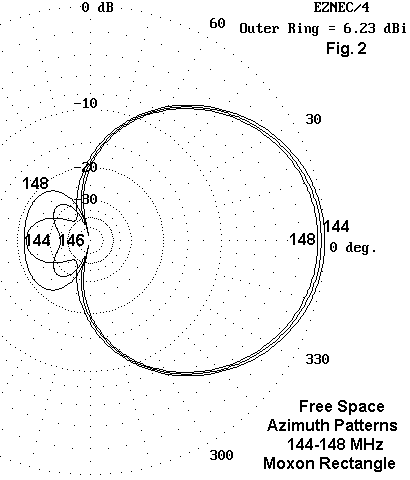
Fig. 2 show free space azimuth patterns of the 1/2" diameter model across the 2-meter band. The design center frequency is 146 MHZ, and both the front-to-back ratio and the feedpoint impedance were optimized for that frequency. The gain differential from 144 to 148 MHz is well under 1 dB. Although the ideal front-to-back ratio holds good only around the design frequency, the front-to-back ratio of this model is nowhere under 20 dB, even at the band edges. The -3 dB beamwidth across the band is between 75 and 80 degrees. The maximum front-to-side ratio does not occur at the usual 90-degree points relative to the direction of maximum forward gain. The maximum front-to-side ratio angles are close to 30 degrees further back in the pattern.
Horizontally and Vertically Polarized Patterns over Ground
At heights above 1/2 wl, the Moxon rectangle feedpoint impedance is very stable and is thus of little concern once established during construction. Elevation angles of maximum radiation accord well with standard dipole based antennas. Therefore, the rectangle might be classed as a "very well behaved" antenna. We can move it from one height to another without worrying about adjustments beyond a secure mounting.
Perhaps the only significant construction worries are these two.
1. Element corners: Bending tubing into the sharp 90-degree angles used in the models is often not feasible. We can manage the trick with 1/4" diameter aluminum rod to form continuous elements. If we use copper tubing, we can solder 90-degree elbows to straight pieces to form sharp angles. If we bend aluminum or copper tubing, the radius of the corner will likely require that we lengthen the side-to-side dimensions a bit to restore the performance curve.
2. Gap-fixing: Aligning the element ends and maintaining both the alignment and the gap distance is critical to long-term use of the rectangle. Wire versions used at HF often stretch the rectangle at the four corners and use a non-stretch section of rope or twine to maintain both alignment and spacing. For larger diameter aluminum tubing, one may place a section of CPVC in the ends of both elements and fasten it with sheet metal screws. The stresses are low enough to give the fixed light-weight spacer good durability.
For rods or smaller diameter tubing used at VHF, we can use a small length of fiberglass rod. The weight of a 2" length should not pose a problem. Heat shrink tubing placed over the rod and element ends will hold everything aligned for a considerable period.
The right applications for a horizontally polarized rectangle are dictated by the pattern, shown in Fig. 3, taken at a typical 2-meter installation height of 30' above the ground.
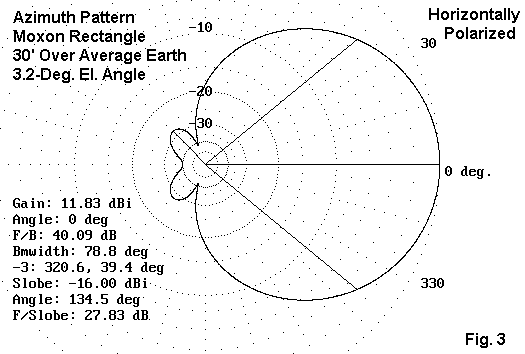
The high-front-to-back ratio suggests that the antenna is most at home in a fixed installation where interference from the rear is more troublesome than signal strength from the forward direction. The wide coverage from the forward direction requires minimal redirection of the antenna under these conditions. Even if the desired station is off the center line, we might best orient the array so that we achieve a maximum null for the source of interference.
Often neglected is the fact that a Moxon rectangle will perform as well when vertically oriented and hence vertically polarized. Fig. 4 shows the azimuth pattern of the rectangle, once more at a 30' height.
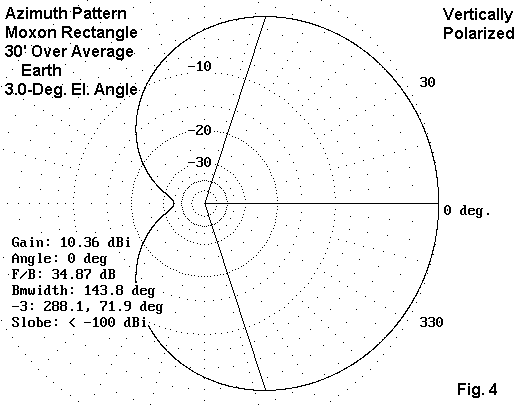
The gain of the vertical rectangle is slightly less than for the horizontal rectangle, but the -3 dB beamwidth is much larger: about 144 degrees, or just shy of a full half compass. There are many repeater applications for such a wide-band and wide-beamwidth antenna, especially in installations where mutual repeater interference is common. One can null out the interfering repeater to a high degree--or one can reduce one's interference to that other repeater.
In multiple antenna installations, the rectangle can be used in conjunction with other rectangles or other types of antennas to achieve full coverage over a desired area. Indeed, proper antenna choice can ease the problem of dead spots and antenna polling indecision.
There are a number of repeater users who live along ridges and in other areas where two repeaters may both be accessed simultaneously. The Moxon rectangle--actually a pair of rectangles--vertically oriented, may present a simple solution.
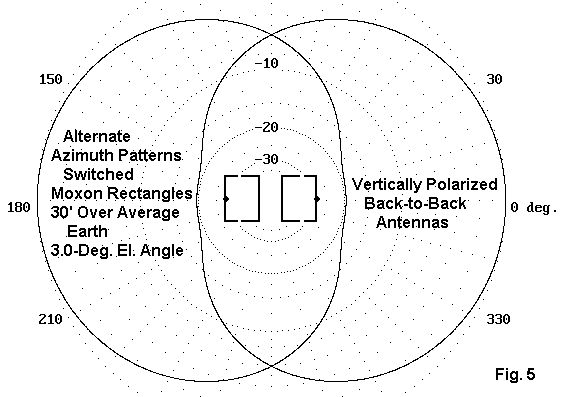
Fig. 5 shows the alternate azimuth patterns of two rectangles back-to-back and separated by about 30 inches. Each antenna is built to the dimensions shown early in this note. The interaction of the active antenna with the inactive reflector is minimal--just enough to reduce the front-to-back ratio to about 20 dB. Interestingly, this front-to-back level and the "flat-back" pattern remains fairly constant across the entire band.
The feedpoint impedance is unaffected by the presence of the inactive antenna to the rear. It should be possible to arrange up to three such rectangles to provide coverage of virtually the entire horizon, one section at a time. The key is to remember to use only one antenna at a time, letting the feedpoint of the other(s) be shorted when inactive. Shorting the unused feedpoints can be accomplished by either electrical or mechanical means.
The Moxon and Satellites
The current generation of amateur satellites do not generally require high gain for either transmission of reception. Indeed, power control is the constant plea of those folks who try to keep the birds active for the benefit of amateur everywhere. For some satellites, a much simpler antenna system may be useful, if not as the station's primary system, then as a back-up when the main array is down for maintenance or improvement.
Can the Moxon rectangle play a role here? See Fig. 6.
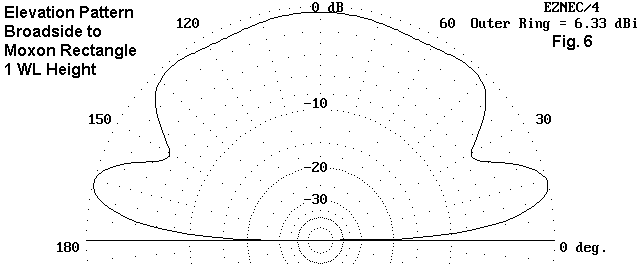
Fig. 6 shows the elevation pattern broadside to a 2-meter Moxon rectangle that is 1 wl off the ground. Although each side of the pattern shows a null, the remaining curve is remarkably smooth and with roughly equal gain from one side to the other.
Elevating the antenna too high will produce a series of lobes and nulls, with consequential ups and downs in signal level. Hence, the use of the rectangle depends on keeping it at a fairly low height. The feasibility of using the antenna in this application therefore depends in part on the collection of ground clutter objects that might adversely affect the pattern.
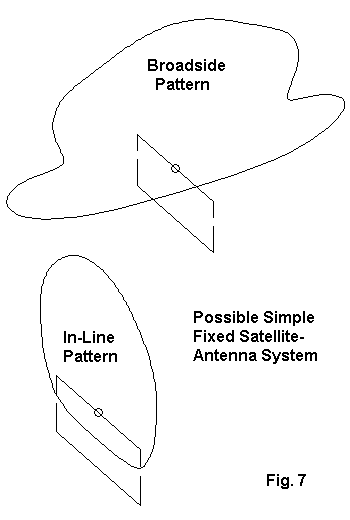
Fig. 7 shows the general outlines of the elevation patterns of the rectangle both broadside to the antenna and in-line with the wires. The 3-dimensional pattern makes a kind of tunnel across the sky from one horizon to the other (or from above the ground clutter to just above it reentry into the picture). Consider the antenna to be mounted so that its plane is at right angles to the usual satellite path across the sky. For overhead paths, a fixed antenna appears capable of providing nearly maximum time for contacts during each pass of the satellite. One limitation of the system is that paths that are lower to the horizon may not be as easily accessed.
One possible cure is to use a pair of fixed rectangles--again switched so that one is active at a time. Each antenna will be tipped in the plane of the wires to make a shallow angle with the ground. Thus, each will be slightly better than the other for lower angle paths, without jeopardizing gain for the overhead paths. The lowest levels will be subject to some pattern skewing, since tilting an antenna does not produce patterns exactly like the overheard pattern. However, the system should handle at least 80% of the fullest possible range of satellite captures.
If polarization becomes an issue, then 2 Moxons can be placed at right angles, crossing (without touching) at their centers. Feeding the two drivers 90 degrees out of phase will equalize the pattern in all directions, and the vertical and horizontal components of their combined fields will be roughly equal. Since each antenna is a good 50-Ohm match at its design frequency, we can use a 50-Ohm, 90-degree phasing line between the two feedpoints. The resultant combined feedpoint impedance will be 25 Ohms. A 35-37-Ohm 1/4 wavelength section will restore the 50-Ohm main line feed impedance.
Elevating the 2-meter Moxon (and possibly a 440 MHz companion) would require the use of a sizable ground screen. Because ground reflection involves a Fresnel zone at some distance to the antenna, small screens are of limited use in overcoming the series of lobes and nulls that appear in the pattern of a highly elevated rectangle. However, providing a screen as a substitute ground is one direction of experimentation that might permit the rectangles to clear most of the ground clutter.
Conclusion and Beginning
We have looked briefly at the Moxon rectangle on 2-meters in all three directions: horizontal, vertical, and straight up. However, we likely have only scratched the surface of possible applications. Indeed, there may be both amateur and commercial applications from 50 MHz up to a GHz. For example, in urban communications--whether via amateur or commercial links--few antennas radiate to the rear as little as the rectangle, and few are likewise as insensitive to radiation from the rear. Hence, the rectangle may be useful in overcoming at least part of the reflection and re-radiation problem common to antennas in the vicinity of building with acres of steel and copper.
By the same token, the Moxon rectangle is not a cure-all for every antenna need. Where gain is the name of the game, long Yagis and arrays of Yagis still rule the roost in the VHF range, while parabolic reflectors command the frequencies from UHF on up. These notes are designed only to show some of what a rectangle can do well. Use it where it fits the need.
Updated 10-01-99, 10-21-99. © L. B. Cebik, W4RNL. This item originally appeared in AntenneX, September, 1999. Data may be used for personal purposes, but may not be reproduced for publication in print or any other medium without permission of the author.